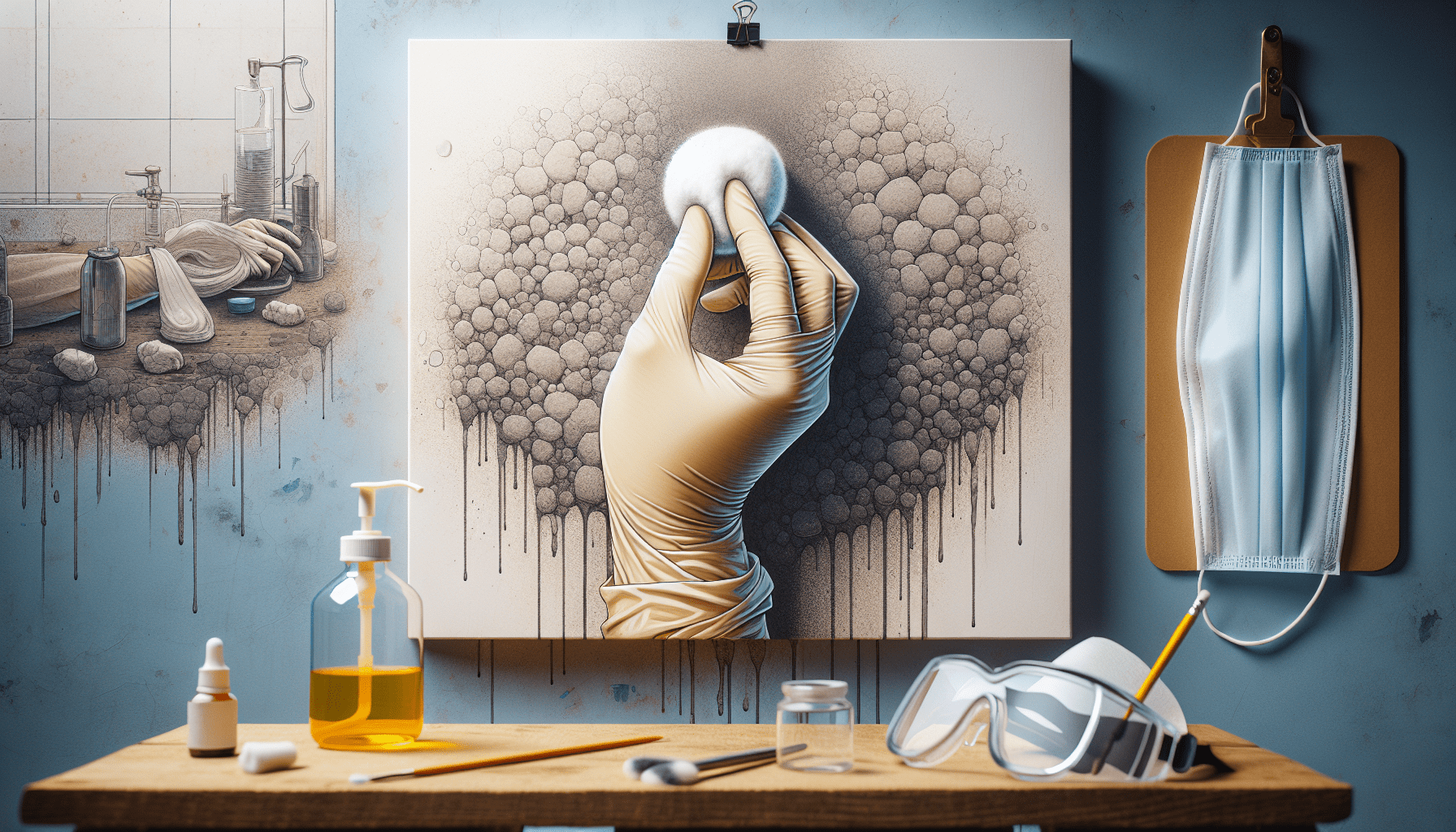If you’ve ever encountered the frustrating task of removing latex paint from a wall, you know it can be a time-consuming and tedious process. However, with the right techniques and tools, you can effectively eliminate those unsightly paint stains without causing damage to the underlying surface. In this article, we will explore step-by-step methods for safely and efficiently removing latex paint from walls, ensuring a smooth and pristine finish. From choosing the appropriate solvents to mastering proper scraping techniques, you’ll discover the expert tips you need to tackle this common household challenge with confidence.
Supplies Needed
To successfully remove latex paint from a wall, you will need a few essential supplies. These include:
Protective gear
It is crucial to prioritize your safety while working with paint removal. Wear appropriate protective gear such as gloves, safety goggles, and a mask to protect your skin, eyes, and respiratory system from any potential harm.
Drop cloth or plastic sheet
Before you begin the paint removal process, it’s important to protect the surrounding area. Place a drop cloth or plastic sheet on the floor to catch any paint chips or spills, preventing them from staining or damaging your floors.
Paint scraper
A paint scraper is an essential tool for removing the bulk of the paint from the wall. Choose a high-quality paint scraper with a comfortable grip to make the scraping process more efficient.
Clean rags
Having clean rags on hand is necessary for wiping away excess paint, cleaning surfaces, and drying the wall after the removal process.
Bucket of warm water
Warm water will be the base of your cleaning solution. Using warm water helps to loosen the paint and make it easier to remove.
Mild dish soap
Add a small amount of mild dish soap to the warm water to create an effective cleaning solution. Avoid harsh chemicals or abrasive cleaners, as they can damage the wall surface.
Sponge or soft scrub brush
A sponge or soft scrub brush will be used to gently scrub away any paint residue from the wall. Choose a non-abrasive sponge or scrub brush to avoid scratching or damaging the surface.
Paint thinner or rubbing alcohol
For stubborn paint stains, you may need to use paint thinner or rubbing alcohol. These solvents help to break down the paint and make it easier to remove.
Plastic wrap
Plastic wrap can be used in combination with a paint remover or stripper to help the product penetrate the paint. It creates a barrier that prevents the product from drying out too quickly.
Fine-grit sandpaper
In some cases, sanding may be necessary to completely remove any remaining paint or to smooth out the wall surface. Opt for fine-grit sandpaper to avoid creating unnecessary damage to the wall.
Preparing the Area
Before you embark on the paint removal process, it’s important to prepare the area properly. Follow these steps to ensure a smooth and efficient process:
Clear the room
Remove any furniture, decor, or other items from the room to provide ample space for maneuvering. This will also protect your belongings from potential damage by paint chips or spills.
Protect floors and furniture
Place a drop cloth or plastic sheet over your floors and any furniture that you are unable to move out of the room. This will prevent these surfaces from being stained or damaged during the paint removal process.
Cover electrical outlets
To ensure your safety, cover electrical outlets with plastic or masking tape before starting the paint removal process. This protective measure will prevent water or paint from seeping into the outlets and causing a potential hazard.
By taking these precautionary steps, you can create a safe and organized environment for removing the latex paint from your wall.

Scraping the Paint
Once you have prepared the area, it’s time to begin removing the paint from the wall. Follow these steps for effective paint scraping:
Start with a paint scraper
Using a paint scraper, gently scrape the surface of the wall to remove the bulk of the loose paint. Hold the scraper at a slight angle, applying even pressure as you move it across the painted area.
Scrape gently to avoid wall damage
To prevent causing damage to the wall surface, ensure that you scrape gently and avoid excessive force. Applying too much pressure or using a sharp object can lead to scratches or gouges in the wall.
Remove the loose paint chips
Collect the loose paint chips that come off during the scraping process using a dustpan or vacuum cleaner with a brush attachment. Dispose of the paint chips properly according to your local regulations for paint waste.
By following these steps, you can effectively remove the majority of the loose paint from the wall, making the subsequent cleaning process more manageable.
Cleaning the Surface
After scraping off the loose paint, it’s important to thoroughly clean the wall surface to remove any remaining paint residue. Follow these steps to achieve a clean and smooth surface:
Create a cleaning solution
Fill a bucket with warm water and add a small amount of mild dish soap. Mix the solution until the soap is dissolved, creating a gentle cleaning agent that will help remove the paint residue.
Dip sponge or scrub brush in the solution
Dip a sponge or soft scrub brush into the cleaning solution, ensuring it is thoroughly soaked. The sponge or brush should be damp but not dripping, as excessive water can damage the wall.
Gently scrub the paint residue
Using the damp sponge or scrub brush, gently scrub the areas where paint residue remains. Apply light pressure and circular motions to lift the paint residue off the wall surface. Continue scrubbing until the residue is no longer visible.
Use clean water to rinse the wall
Fill a separate bucket with clean water. Rinse the sponge or scrub brush in the clean water and wipe down the wall to remove any soapy residue. This step ensures that no soap is left behind on the wall surface.
Dry the surface
After rinsing the wall, use a clean rag or towel to dry the surface thoroughly. This will prevent any water spots or streaks from forming once the wall is dry. Take care to pat the surface dry rather than rubbing, as rubbing may cause the paint residue to smear.
By following these cleaning steps, you can effectively remove paint residue and achieve a clean and prep-ready wall surface.

Using Paint Thinner or Rubbing Alcohol
For stubborn and harder-to-remove paint stains, the use of paint thinner or rubbing alcohol may be necessary. Follow these steps to effectively use these solvents:
Test in an inconspicuous area
Before applying the paint thinner or rubbing alcohol to the whole wall, perform a patch test in an inconspicuous area. Apply a small amount of the solvent and observe the wall’s reaction. If there are no adverse effects, proceed with the following steps.
Apply paint thinner or rubbing alcohol
Wet a clean rag with the chosen solvent, either paint thinner or rubbing alcohol. Gently dab the stained area with the rag, ensuring that the stain is saturated with the solvent. Allow the solvent to penetrate the stain for a few minutes.
Let it sit for a few minutes
Give the paint thinner or rubbing alcohol time to work its magic. Allowing it to sit on the stain for a few minutes will help soften the paint, making it easier to remove.
Scrape off the softened paint
Using a paint scraper, gently scrape off the softened paint from the wall surface. Be cautious not to apply too much pressure, as this may damage the underlying wall.
Repeat if necessary
Some stubborn stains may require multiple rounds of applying the solvent and scraping. If necessary, repeat the process until the stain is fully removed.
By meticulously following these steps, you can effectively remove stubborn paint stains, restoring your wall to its original condition.
Removing Stubborn Stains
In some cases, certain stains may prove to be more resistant to traditional cleaning methods. To combat these stubborn stains, follow these steps:
Make a paste with water and baking soda
In a small bowl, mix together a paste using water and baking soda. The paste should have a consistency similar to toothpaste.
Apply the paste to the stains
Using a clean rag or sponge, apply the paste directly to the stubborn stains. Ensure that the paste is evenly spread over the affected area.
Gently scrub the area
Using circular motions, gently scrub the stained area with the paste. Apply moderate pressure to lift the stain off the wall surface.
Remove the paste using a clean cloth
Once the stain has been scrubbed, use a clean and damp cloth to remove the paste from the wall. Rinse the cloth frequently to ensure the paste is completely wiped away.
Repeat if needed
If the stain persists, repeat the process and apply a fresh coat of the baking soda paste. Continue the gentle scrubbing until the stain is no longer visible.
By utilizing the power of baking soda, you can effectively tackle and eliminate stubborn stains on your wall surfaces.
Using Plastic Wrap
For particularly challenging paint removal situations, the use of a paint remover or stripper combined with plastic wrap can be highly effective. Follow these steps to utilize this method successfully:
Apply a paint remover or stripper
Choose a high-quality paint remover or stripper and apply it to the stubborn paint areas. Follow the manufacturer’s instructions for the specific product you are using.
Cover with plastic wrap
After applying the paint remover or stripper, immediately cover the treated areas with plastic wrap. Ensure that the plastic wrap adheres tightly to the wall surface, creating a barrier that prevents the product from drying out too quickly.
Let it sit for the recommended time
Allow the paint remover or stripper to sit on the wall surface for the recommended amount of time specified by the product’s instructions. This will allow the product to penetrate the paint and soften it for easier removal.
Peel off the plastic wrap
After the recommended time has passed, carefully peel off the plastic wrap from the wall surface. Be cautious not to disturb the softened paint underneath.
Scrape off the softened paint
Using a paint scraper, gently scrape off the softened paint from the wall surface. The paint should come off more easily due to the paint remover or stripper’s effects.
By following these steps, you can effectively address more challenging paint removal scenarios, ensuring the successful removal of stubborn paint from your walls.
Finishing Touches
After successfully removing the latex paint from your wall, it’s important to complete the process with some final touches. Follow these steps for a clean and finished result:
Inspect the wall for any remaining paint
Carefully examine the wall to ensure that all traces of paint have been successfully removed. Address any remaining paint spots or residue using the appropriate removal method discussed earlier.
Sand the surface if necessary
If there are any rough patches or uneven areas on the wall, lightly sand the surface using fine-grit sandpaper. This will help smooth out the wall, creating a uniform and flawless finish.
Clean the wall with mild soap and water
Give the wall a final cleaning using a mild soap and water solution. This step will remove any residual dust or debris from the removal process, ensuring a pristine surface.
Rinse and dry the surface
Thoroughly rinse the wall with clean water to remove any soap residue. Once rinsed, use a clean rag or towel to dry the surface completely. This final drying step will prevent water spots or streaks from forming.
Prime and repaint if desired
If you plan to repaint the wall, apply a coat of primer to create a smooth and even base before the final paint application. This step will help the new paint adhere better and provide a more durable finish.
By carrying out these finishing touches, you can ensure a clean and professional-looking wall surface, ready for any further treatment or paint application.
Safety Precautions
When engaging in any paint removal process, it is essential to prioritize safety. Follow these safety precautions to protect yourself and others:
Wear protective gear
Always wear appropriate protective gear, including gloves, safety goggles, and a mask, to safeguard against any potential chemical exposure or injury during the paint removal process.
Ensure good ventilation
Work in a well-ventilated area to minimize the inhalation of any fumes or chemicals used during the paint removal process. Open windows or use fans to promote air circulation and keep fresh air flowing.
Avoid open flames or sparks
Avoid working near open flames or sparks, as some solvents or paint removers can be highly flammable. This precaution will prevent any accidental ignition or fires.
Properly dispose of paint waste
Dispose of any paint chips, cleaning materials, or solvents used during the removal process in accordance with local regulations. Avoid pouring any chemicals down the drain and instead dispose of them in designated waste collection sites.
By adhering to these safety precautions, you can remove latex paint from walls while minimizing potential risks or accidents.
Professional Help
In some instances, removing latex paint from walls may be a complex or time-consuming task. If you feel overwhelmed or unsure about tackling the job yourself, it may be wise to consider hiring a professional.
Consider hiring a professional
Professional painters and contractors possess the necessary knowledge, expertise, and equipment to handle paint removal tasks efficiently and effectively. Hiring a professional can save you time and provide peace of mind, knowing that the job will be done correctly.
Seek advice or assistance if needed
If you decide to tackle the paint removal process yourself but encounter any challenges or difficulties, don’t hesitate to seek advice or assistance. Consult with paint experts at your local hardware store or reach out to professionals in the field for guidance.
By reaching out to professionals, you can benefit from their experience and ensure a successful paint removal process.
In conclusion, removing latex paint from walls requires careful preparation, the right tools and materials, and a systematic approach. By following the comprehensive steps outlined in this article and prioritizing safety, you can effectively remove paint from your walls and achieve a clean, pristine surface. Whether you decide to handle the paint removal process yourself or seek professional help, you now have the knowledge and guidelines to safely and successfully remove latex paint from your walls.



